Does Creating Awareness on HIV/AIDS Help in Reducing New Infection Among the Aboriginals and Torres Strait Islanders?
VerifiedAdded on 2023/06/12
|13
|3124
|329
AI Summary
This study investigates whether creating awareness on HIV/AIDS can help in reducing the spread of the epidemic among Aboriginals and Torres Strait Islanders in Australia. The study aims to determine the extent of information reach to the indigenous people through the internet and other media outlets in Australia on HIV/AIDS.
Contribute Materials
Your contribution can guide someone’s learning journey. Share your
documents today.
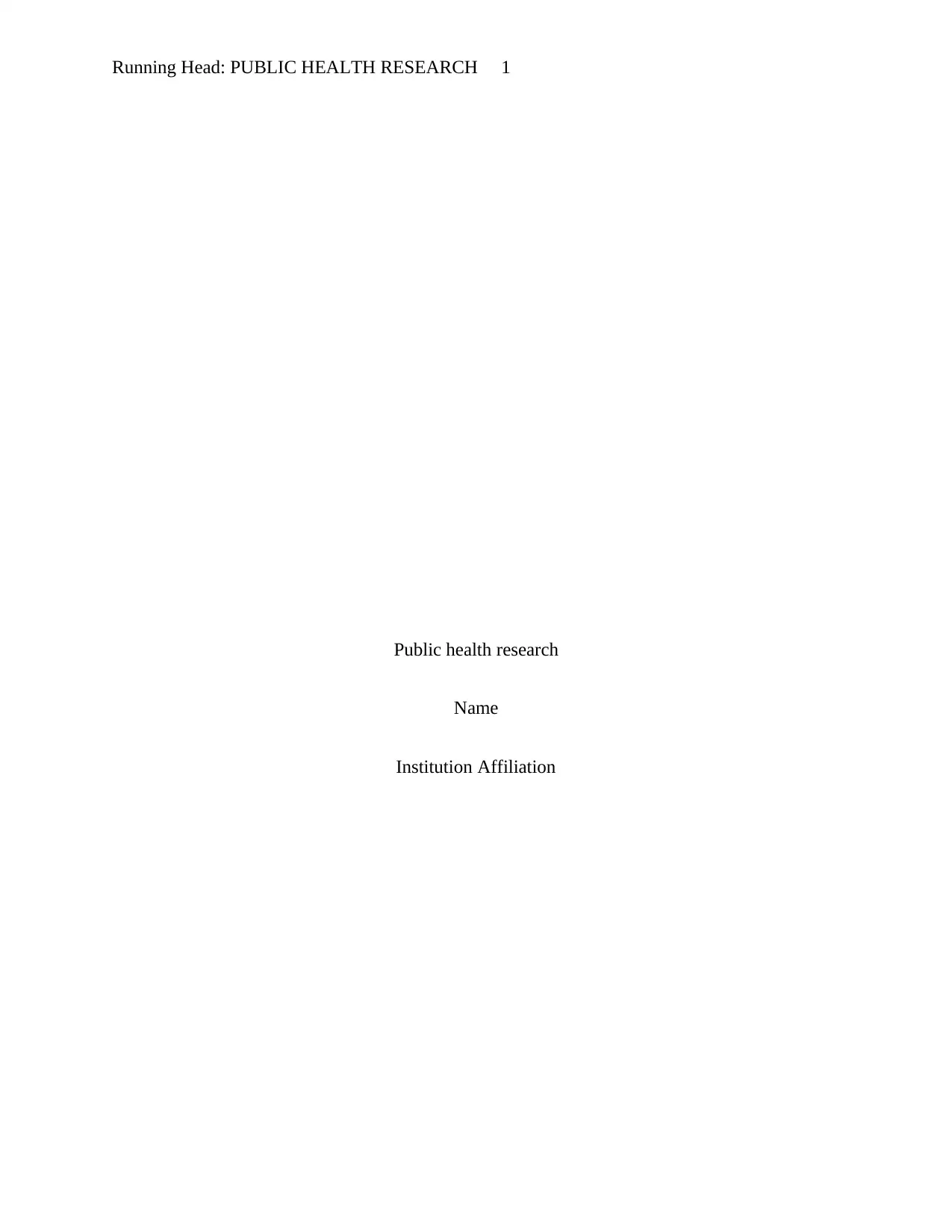
Running Head: PUBLIC HEALTH RESEARCH 1
Public health research
Name
Institution Affiliation
Public health research
Name
Institution Affiliation
Secure Best Marks with AI Grader
Need help grading? Try our AI Grader for instant feedback on your assignments.
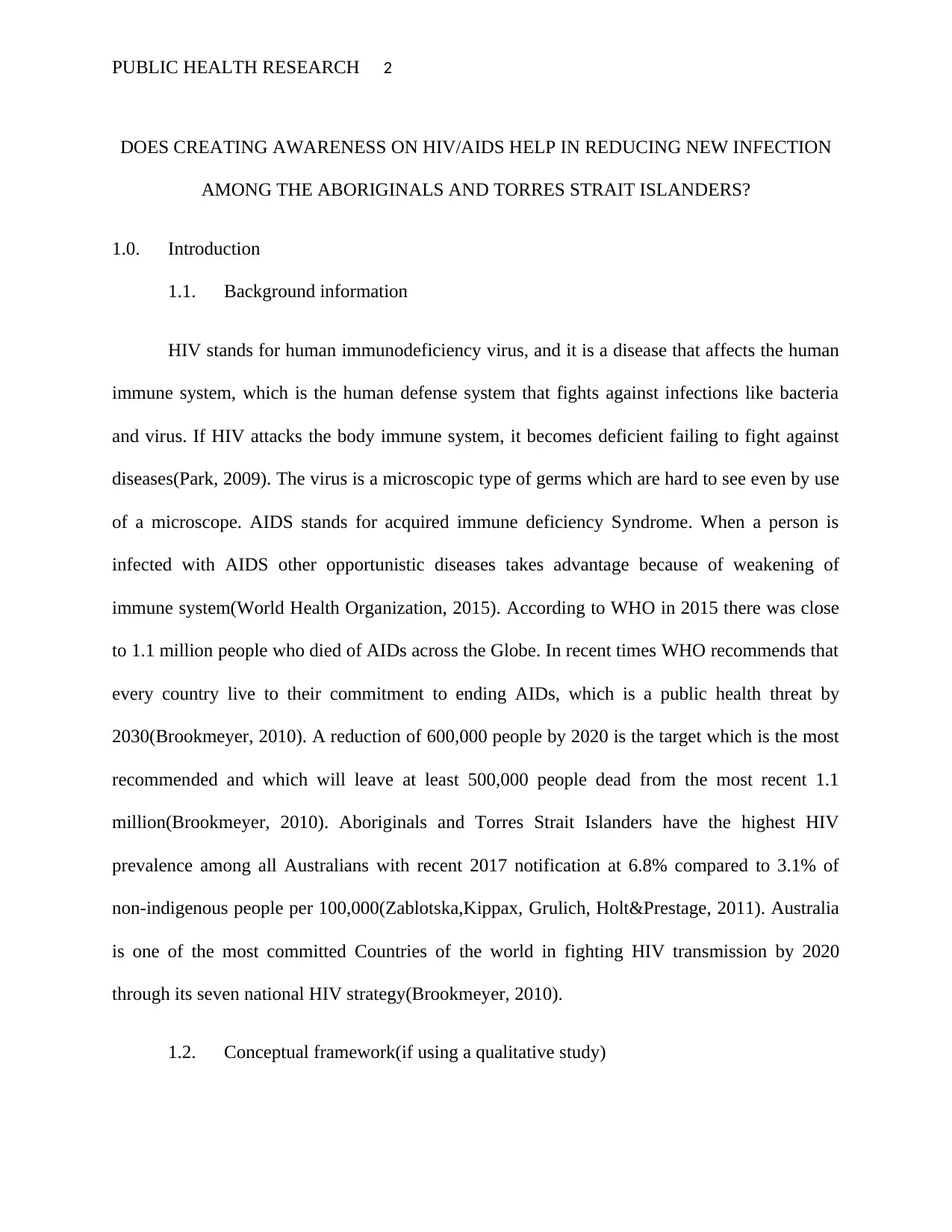
PUBLIC HEALTH RESEARCH 2
DOES CREATING AWARENESS ON HIV/AIDS HELP IN REDUCING NEW INFECTION
AMONG THE ABORIGINALS AND TORRES STRAIT ISLANDERS?
1.0. Introduction
1.1. Background information
HIV stands for human immunodeficiency virus, and it is a disease that affects the human
immune system, which is the human defense system that fights against infections like bacteria
and virus. If HIV attacks the body immune system, it becomes deficient failing to fight against
diseases(Park, 2009). The virus is a microscopic type of germs which are hard to see even by use
of a microscope. AIDS stands for acquired immune deficiency Syndrome. When a person is
infected with AIDS other opportunistic diseases takes advantage because of weakening of
immune system(World Health Organization, 2015). According to WHO in 2015 there was close
to 1.1 million people who died of AIDs across the Globe. In recent times WHO recommends that
every country live to their commitment to ending AIDs, which is a public health threat by
2030(Brookmeyer, 2010). A reduction of 600,000 people by 2020 is the target which is the most
recommended and which will leave at least 500,000 people dead from the most recent 1.1
million(Brookmeyer, 2010). Aboriginals and Torres Strait Islanders have the highest HIV
prevalence among all Australians with recent 2017 notification at 6.8% compared to 3.1% of
non-indigenous people per 100,000(Zablotska,Kippax, Grulich, Holt&Prestage, 2011). Australia
is one of the most committed Countries of the world in fighting HIV transmission by 2020
through its seven national HIV strategy(Brookmeyer, 2010).
1.2. Conceptual framework(if using a qualitative study)
DOES CREATING AWARENESS ON HIV/AIDS HELP IN REDUCING NEW INFECTION
AMONG THE ABORIGINALS AND TORRES STRAIT ISLANDERS?
1.0. Introduction
1.1. Background information
HIV stands for human immunodeficiency virus, and it is a disease that affects the human
immune system, which is the human defense system that fights against infections like bacteria
and virus. If HIV attacks the body immune system, it becomes deficient failing to fight against
diseases(Park, 2009). The virus is a microscopic type of germs which are hard to see even by use
of a microscope. AIDS stands for acquired immune deficiency Syndrome. When a person is
infected with AIDS other opportunistic diseases takes advantage because of weakening of
immune system(World Health Organization, 2015). According to WHO in 2015 there was close
to 1.1 million people who died of AIDs across the Globe. In recent times WHO recommends that
every country live to their commitment to ending AIDs, which is a public health threat by
2030(Brookmeyer, 2010). A reduction of 600,000 people by 2020 is the target which is the most
recommended and which will leave at least 500,000 people dead from the most recent 1.1
million(Brookmeyer, 2010). Aboriginals and Torres Strait Islanders have the highest HIV
prevalence among all Australians with recent 2017 notification at 6.8% compared to 3.1% of
non-indigenous people per 100,000(Zablotska,Kippax, Grulich, Holt&Prestage, 2011). Australia
is one of the most committed Countries of the world in fighting HIV transmission by 2020
through its seven national HIV strategy(Brookmeyer, 2010).
1.2. Conceptual framework(if using a qualitative study)
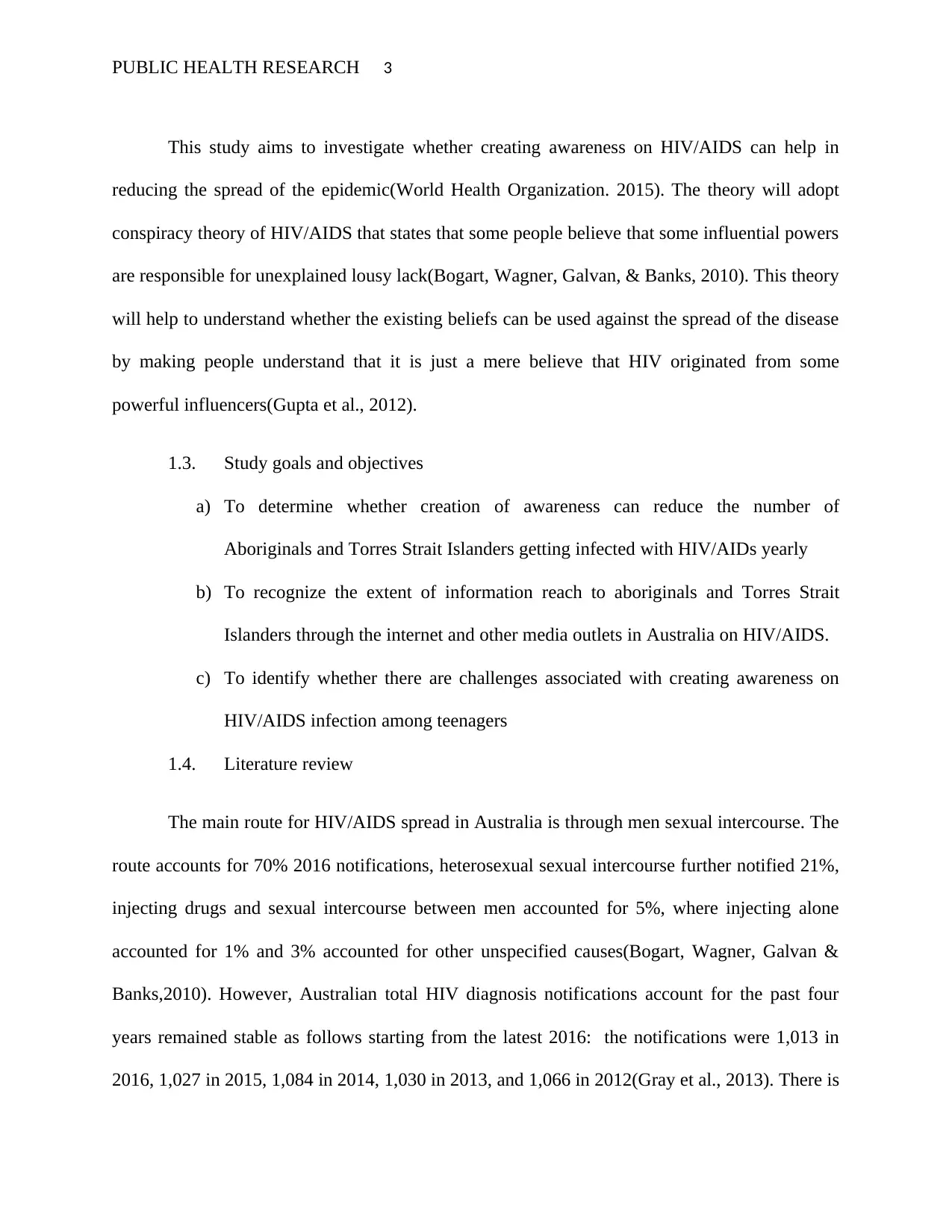
PUBLIC HEALTH RESEARCH 3
This study aims to investigate whether creating awareness on HIV/AIDS can help in
reducing the spread of the epidemic(World Health Organization. 2015). The theory will adopt
conspiracy theory of HIV/AIDS that states that some people believe that some influential powers
are responsible for unexplained lousy lack(Bogart, Wagner, Galvan, & Banks, 2010). This theory
will help to understand whether the existing beliefs can be used against the spread of the disease
by making people understand that it is just a mere believe that HIV originated from some
powerful influencers(Gupta et al., 2012).
1.3. Study goals and objectives
a) To determine whether creation of awareness can reduce the number of
Aboriginals and Torres Strait Islanders getting infected with HIV/AIDs yearly
b) To recognize the extent of information reach to aboriginals and Torres Strait
Islanders through the internet and other media outlets in Australia on HIV/AIDS.
c) To identify whether there are challenges associated with creating awareness on
HIV/AIDS infection among teenagers
1.4. Literature review
The main route for HIV/AIDS spread in Australia is through men sexual intercourse. The
route accounts for 70% 2016 notifications, heterosexual sexual intercourse further notified 21%,
injecting drugs and sexual intercourse between men accounted for 5%, where injecting alone
accounted for 1% and 3% accounted for other unspecified causes(Bogart, Wagner, Galvan &
Banks,2010). However, Australian total HIV diagnosis notifications account for the past four
years remained stable as follows starting from the latest 2016: the notifications were 1,013 in
2016, 1,027 in 2015, 1,084 in 2014, 1,030 in 2013, and 1,066 in 2012(Gray et al., 2013). There is
This study aims to investigate whether creating awareness on HIV/AIDS can help in
reducing the spread of the epidemic(World Health Organization. 2015). The theory will adopt
conspiracy theory of HIV/AIDS that states that some people believe that some influential powers
are responsible for unexplained lousy lack(Bogart, Wagner, Galvan, & Banks, 2010). This theory
will help to understand whether the existing beliefs can be used against the spread of the disease
by making people understand that it is just a mere believe that HIV originated from some
powerful influencers(Gupta et al., 2012).
1.3. Study goals and objectives
a) To determine whether creation of awareness can reduce the number of
Aboriginals and Torres Strait Islanders getting infected with HIV/AIDs yearly
b) To recognize the extent of information reach to aboriginals and Torres Strait
Islanders through the internet and other media outlets in Australia on HIV/AIDS.
c) To identify whether there are challenges associated with creating awareness on
HIV/AIDS infection among teenagers
1.4. Literature review
The main route for HIV/AIDS spread in Australia is through men sexual intercourse. The
route accounts for 70% 2016 notifications, heterosexual sexual intercourse further notified 21%,
injecting drugs and sexual intercourse between men accounted for 5%, where injecting alone
accounted for 1% and 3% accounted for other unspecified causes(Bogart, Wagner, Galvan &
Banks,2010). However, Australian total HIV diagnosis notifications account for the past four
years remained stable as follows starting from the latest 2016: the notifications were 1,013 in
2016, 1,027 in 2015, 1,084 in 2014, 1,030 in 2013, and 1,066 in 2012(Gray et al., 2013). There is
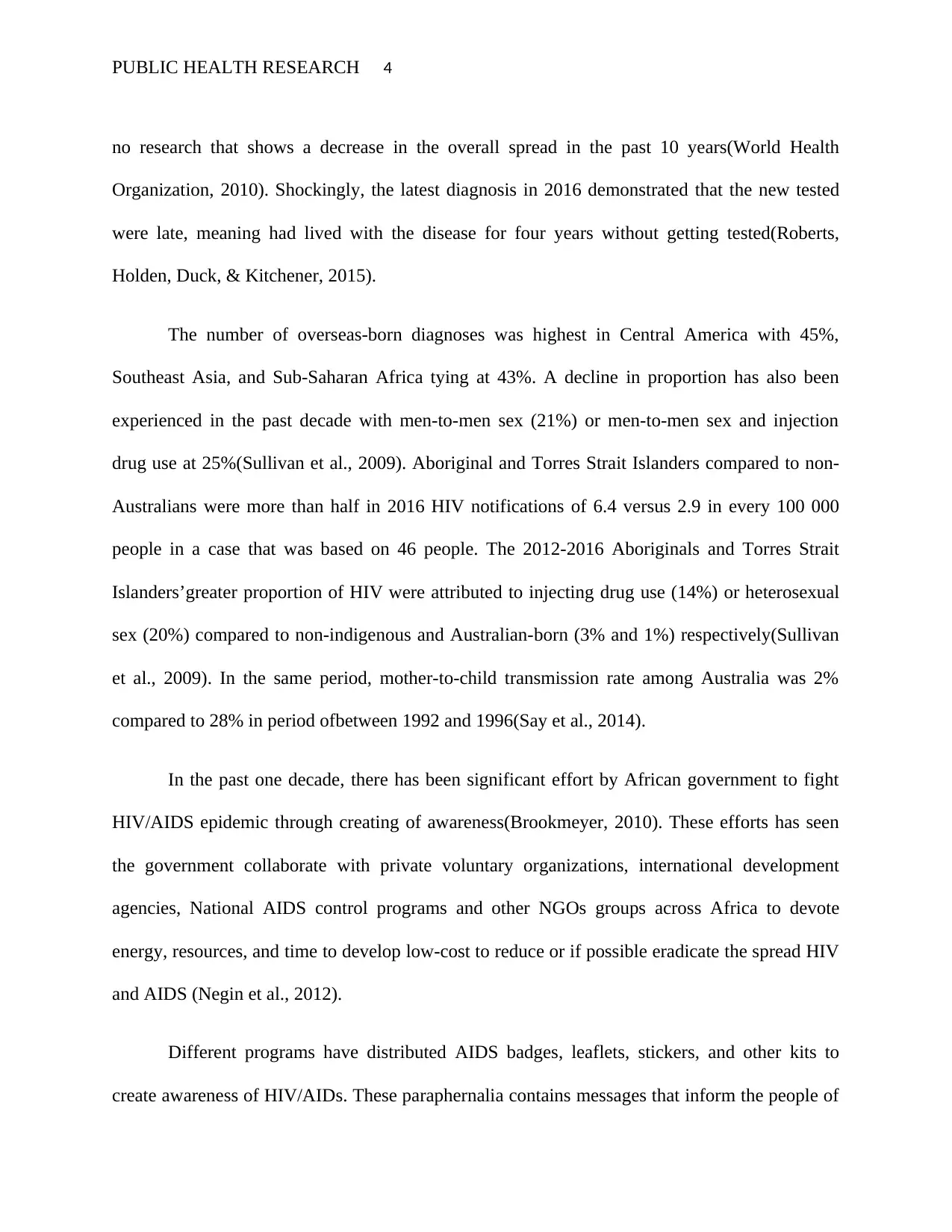
PUBLIC HEALTH RESEARCH 4
no research that shows a decrease in the overall spread in the past 10 years(World Health
Organization, 2010). Shockingly, the latest diagnosis in 2016 demonstrated that the new tested
were late, meaning had lived with the disease for four years without getting tested(Roberts,
Holden, Duck, & Kitchener, 2015).
The number of overseas-born diagnoses was highest in Central America with 45%,
Southeast Asia, and Sub-Saharan Africa tying at 43%. A decline in proportion has also been
experienced in the past decade with men-to-men sex (21%) or men-to-men sex and injection
drug use at 25%(Sullivan et al., 2009). Aboriginal and Torres Strait Islanders compared to non-
Australians were more than half in 2016 HIV notifications of 6.4 versus 2.9 in every 100 000
people in a case that was based on 46 people. The 2012-2016 Aboriginals and Torres Strait
Islanders’greater proportion of HIV were attributed to injecting drug use (14%) or heterosexual
sex (20%) compared to non-indigenous and Australian-born (3% and 1%) respectively(Sullivan
et al., 2009). In the same period, mother-to-child transmission rate among Australia was 2%
compared to 28% in period ofbetween 1992 and 1996(Say et al., 2014).
In the past one decade, there has been significant effort by African government to fight
HIV/AIDS epidemic through creating of awareness(Brookmeyer, 2010). These efforts has seen
the government collaborate with private voluntary organizations, international development
agencies, National AIDS control programs and other NGOs groups across Africa to devote
energy, resources, and time to develop low-cost to reduce or if possible eradicate the spread HIV
and AIDS (Negin et al., 2012).
Different programs have distributed AIDS badges, leaflets, stickers, and other kits to
create awareness of HIV/AIDs. These paraphernalia contains messages that inform the people of
no research that shows a decrease in the overall spread in the past 10 years(World Health
Organization, 2010). Shockingly, the latest diagnosis in 2016 demonstrated that the new tested
were late, meaning had lived with the disease for four years without getting tested(Roberts,
Holden, Duck, & Kitchener, 2015).
The number of overseas-born diagnoses was highest in Central America with 45%,
Southeast Asia, and Sub-Saharan Africa tying at 43%. A decline in proportion has also been
experienced in the past decade with men-to-men sex (21%) or men-to-men sex and injection
drug use at 25%(Sullivan et al., 2009). Aboriginal and Torres Strait Islanders compared to non-
Australians were more than half in 2016 HIV notifications of 6.4 versus 2.9 in every 100 000
people in a case that was based on 46 people. The 2012-2016 Aboriginals and Torres Strait
Islanders’greater proportion of HIV were attributed to injecting drug use (14%) or heterosexual
sex (20%) compared to non-indigenous and Australian-born (3% and 1%) respectively(Sullivan
et al., 2009). In the same period, mother-to-child transmission rate among Australia was 2%
compared to 28% in period ofbetween 1992 and 1996(Say et al., 2014).
In the past one decade, there has been significant effort by African government to fight
HIV/AIDS epidemic through creating of awareness(Brookmeyer, 2010). These efforts has seen
the government collaborate with private voluntary organizations, international development
agencies, National AIDS control programs and other NGOs groups across Africa to devote
energy, resources, and time to develop low-cost to reduce or if possible eradicate the spread HIV
and AIDS (Negin et al., 2012).
Different programs have distributed AIDS badges, leaflets, stickers, and other kits to
create awareness of HIV/AIDs. These paraphernalia contains messages that inform the people of
Secure Best Marks with AI Grader
Need help grading? Try our AI Grader for instant feedback on your assignments.
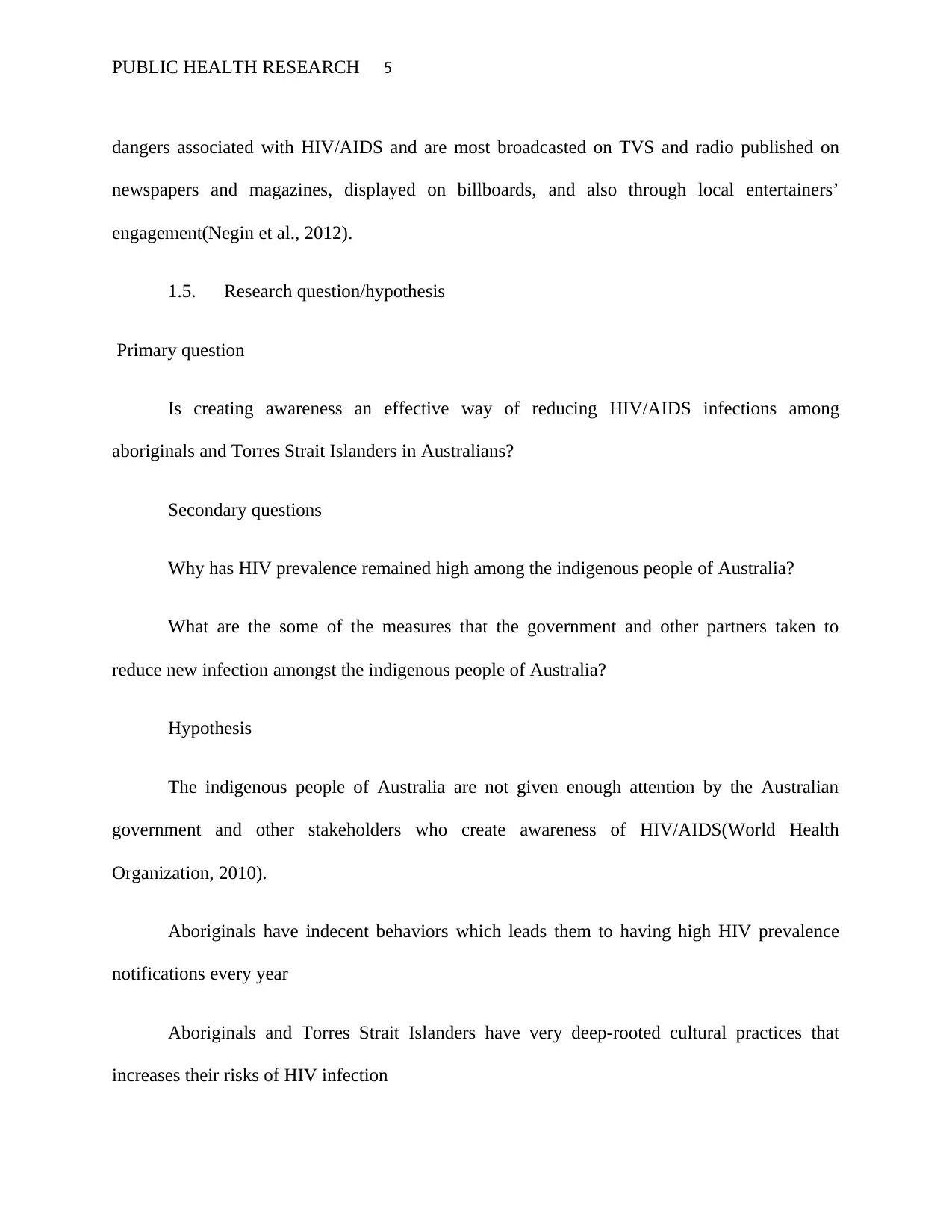
PUBLIC HEALTH RESEARCH 5
dangers associated with HIV/AIDS and are most broadcasted on TVS and radio published on
newspapers and magazines, displayed on billboards, and also through local entertainers’
engagement(Negin et al., 2012).
1.5. Research question/hypothesis
Primary question
Is creating awareness an effective way of reducing HIV/AIDS infections among
aboriginals and Torres Strait Islanders in Australians?
Secondary questions
Why has HIV prevalence remained high among the indigenous people of Australia?
What are the some of the measures that the government and other partners taken to
reduce new infection amongst the indigenous people of Australia?
Hypothesis
The indigenous people of Australia are not given enough attention by the Australian
government and other stakeholders who create awareness of HIV/AIDS(World Health
Organization, 2010).
Aboriginals have indecent behaviors which leads them to having high HIV prevalence
notifications every year
Aboriginals and Torres Strait Islanders have very deep-rooted cultural practices that
increases their risks of HIV infection
dangers associated with HIV/AIDS and are most broadcasted on TVS and radio published on
newspapers and magazines, displayed on billboards, and also through local entertainers’
engagement(Negin et al., 2012).
1.5. Research question/hypothesis
Primary question
Is creating awareness an effective way of reducing HIV/AIDS infections among
aboriginals and Torres Strait Islanders in Australians?
Secondary questions
Why has HIV prevalence remained high among the indigenous people of Australia?
What are the some of the measures that the government and other partners taken to
reduce new infection amongst the indigenous people of Australia?
Hypothesis
The indigenous people of Australia are not given enough attention by the Australian
government and other stakeholders who create awareness of HIV/AIDS(World Health
Organization, 2010).
Aboriginals have indecent behaviors which leads them to having high HIV prevalence
notifications every year
Aboriginals and Torres Strait Islanders have very deep-rooted cultural practices that
increases their risks of HIV infection

PUBLIC HEALTH RESEARCH 6
1.6. Research design and methodology
Quantitative research
The project will apply quantitative research design by use of internet resources and
questionnaire hence avoiding the subjective risks errors that is likely to occur as a result of using
disorganized qualitative research process. Quantitative research design will be more useful since
it is more objective than qualitative design. The design will apply online survey technique and
involve 10 focus groups around the university as a sample size of the study.
Internet is the primary source of the data used in this study as it contains important data
from the world known scholars, experts, and researchers whose data are more reliable.
Qualitative design will answer the question “who” is involved in creating awareness and who
needs the awareness. It will also apply online survey where there is a large number of respondent
will be involved to provide with information to analyze quantitatively.
This study will have limitations in terms of lacking moderation as it requires stimulus
presented to be more functional without a need for interpretation from a moderator. The design
also makes it difficult to prove the contributors in the moment during their responses.
The study will use sample size from the university ranging from 500-1500 of aboriginals,
and Torres Strait Islanders who are seeking HIV test, HIV positive and those around local
community and the university(Gray et al., 2013).
The data collection tool will be a questionnaire which are set of questions logically and
sequentially prepared to take a respondent through a process of diverging information. The
1.6. Research design and methodology
Quantitative research
The project will apply quantitative research design by use of internet resources and
questionnaire hence avoiding the subjective risks errors that is likely to occur as a result of using
disorganized qualitative research process. Quantitative research design will be more useful since
it is more objective than qualitative design. The design will apply online survey technique and
involve 10 focus groups around the university as a sample size of the study.
Internet is the primary source of the data used in this study as it contains important data
from the world known scholars, experts, and researchers whose data are more reliable.
Qualitative design will answer the question “who” is involved in creating awareness and who
needs the awareness. It will also apply online survey where there is a large number of respondent
will be involved to provide with information to analyze quantitatively.
This study will have limitations in terms of lacking moderation as it requires stimulus
presented to be more functional without a need for interpretation from a moderator. The design
also makes it difficult to prove the contributors in the moment during their responses.
The study will use sample size from the university ranging from 500-1500 of aboriginals,
and Torres Strait Islanders who are seeking HIV test, HIV positive and those around local
community and the university(Gray et al., 2013).
The data collection tool will be a questionnaire which are set of questions logically and
sequentially prepared to take a respondent through a process of diverging information. The

PUBLIC HEALTH RESEARCH 7
questions will be supplied to the respondent and picked after completion for better data
management.
The analysis technique will involve scrutinizing of completed questionnaires and data
obtained from internet, and the obtained information will help in coming up with charts, graphs,
tables, percentages, and graphs derived by computer program, MS Word.
These limitations raises need to combine qualitative and quantitative to research designs
to come up with the most build up strengths of both approaches(Zubricket al., 2010). This is
because qualitative approach helps in understanding human behavior and also limited to grounds
in which generalization of findings can be made(Park, 2009).
Based on the previous conducted on aboriginals in both clinical and community level we
intend for quantitative approach to choose 50-500 aboriginals from each samples of HIV positive
indigenous people, indigenous people seeking HIV test, and indigenous people in University and
community at large(Gray et al., 2013).
1.7. Expected study outcomes
This study will be useful to add on the existing Australian knowledge on HIV prevention
methods and apply it in its 2020 Seventh National HIV Strategy to totally eradicate HIV/AIDS.
Our research will help the government reduce its cost incurred on treating the new cases of HIV
every year(Lu et al., 2010).
1.8. Dissemination
questions will be supplied to the respondent and picked after completion for better data
management.
The analysis technique will involve scrutinizing of completed questionnaires and data
obtained from internet, and the obtained information will help in coming up with charts, graphs,
tables, percentages, and graphs derived by computer program, MS Word.
These limitations raises need to combine qualitative and quantitative to research designs
to come up with the most build up strengths of both approaches(Zubricket al., 2010). This is
because qualitative approach helps in understanding human behavior and also limited to grounds
in which generalization of findings can be made(Park, 2009).
Based on the previous conducted on aboriginals in both clinical and community level we
intend for quantitative approach to choose 50-500 aboriginals from each samples of HIV positive
indigenous people, indigenous people seeking HIV test, and indigenous people in University and
community at large(Gray et al., 2013).
1.7. Expected study outcomes
This study will be useful to add on the existing Australian knowledge on HIV prevention
methods and apply it in its 2020 Seventh National HIV Strategy to totally eradicate HIV/AIDS.
Our research will help the government reduce its cost incurred on treating the new cases of HIV
every year(Lu et al., 2010).
1.8. Dissemination
Paraphrase This Document
Need a fresh take? Get an instant paraphrase of this document with our AI Paraphraser
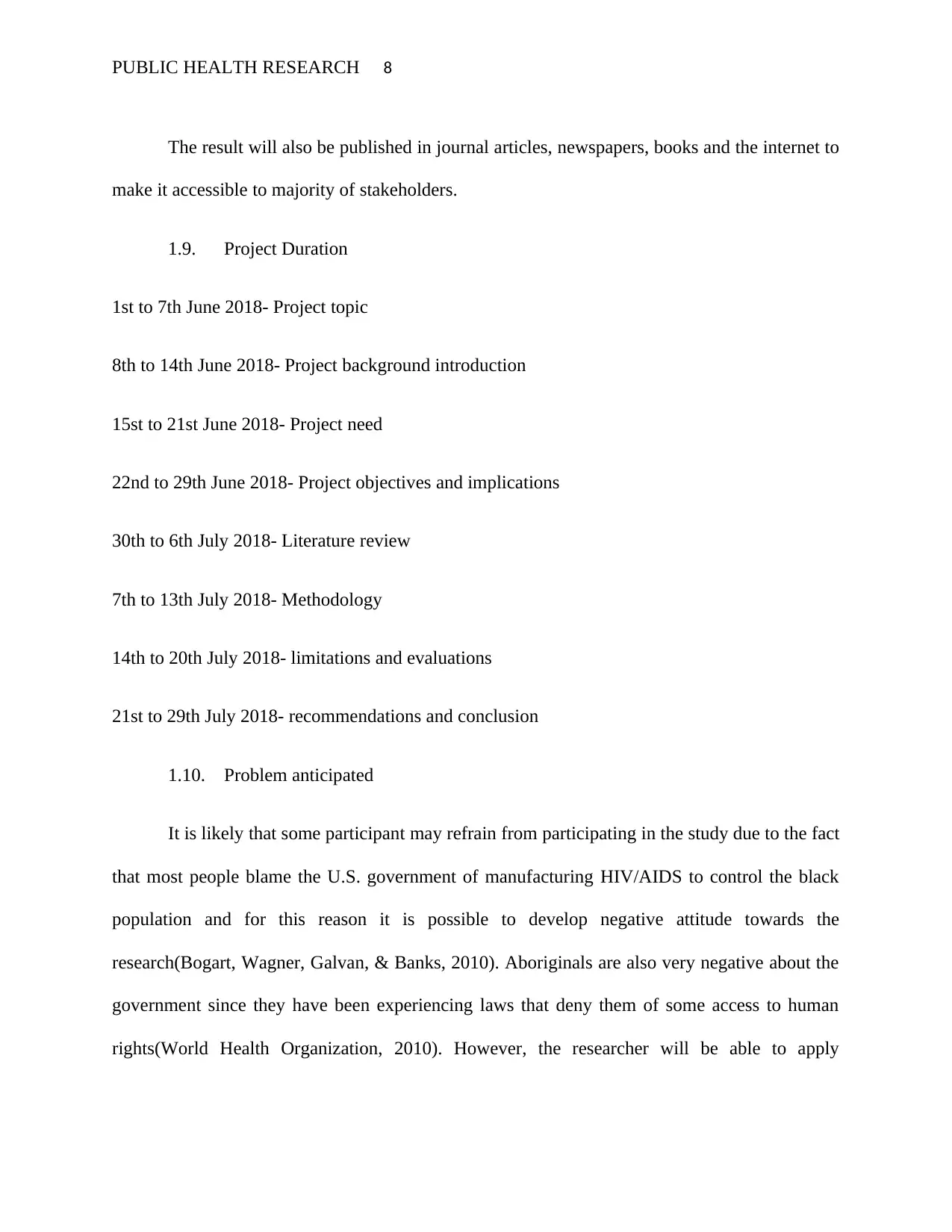
PUBLIC HEALTH RESEARCH 8
The result will also be published in journal articles, newspapers, books and the internet to
make it accessible to majority of stakeholders.
1.9. Project Duration
1st to 7th June 2018- Project topic
8th to 14th June 2018- Project background introduction
15st to 21st June 2018- Project need
22nd to 29th June 2018- Project objectives and implications
30th to 6th July 2018- Literature review
7th to 13th July 2018- Methodology
14th to 20th July 2018- limitations and evaluations
21st to 29th July 2018- recommendations and conclusion
1.10. Problem anticipated
It is likely that some participant may refrain from participating in the study due to the fact
that most people blame the U.S. government of manufacturing HIV/AIDS to control the black
population and for this reason it is possible to develop negative attitude towards the
research(Bogart, Wagner, Galvan, & Banks, 2010). Aboriginals are also very negative about the
government since they have been experiencing laws that deny them of some access to human
rights(World Health Organization, 2010). However, the researcher will be able to apply
The result will also be published in journal articles, newspapers, books and the internet to
make it accessible to majority of stakeholders.
1.9. Project Duration
1st to 7th June 2018- Project topic
8th to 14th June 2018- Project background introduction
15st to 21st June 2018- Project need
22nd to 29th June 2018- Project objectives and implications
30th to 6th July 2018- Literature review
7th to 13th July 2018- Methodology
14th to 20th July 2018- limitations and evaluations
21st to 29th July 2018- recommendations and conclusion
1.10. Problem anticipated
It is likely that some participant may refrain from participating in the study due to the fact
that most people blame the U.S. government of manufacturing HIV/AIDS to control the black
population and for this reason it is possible to develop negative attitude towards the
research(Bogart, Wagner, Galvan, & Banks, 2010). Aboriginals are also very negative about the
government since they have been experiencing laws that deny them of some access to human
rights(World Health Organization, 2010). However, the researcher will be able to apply
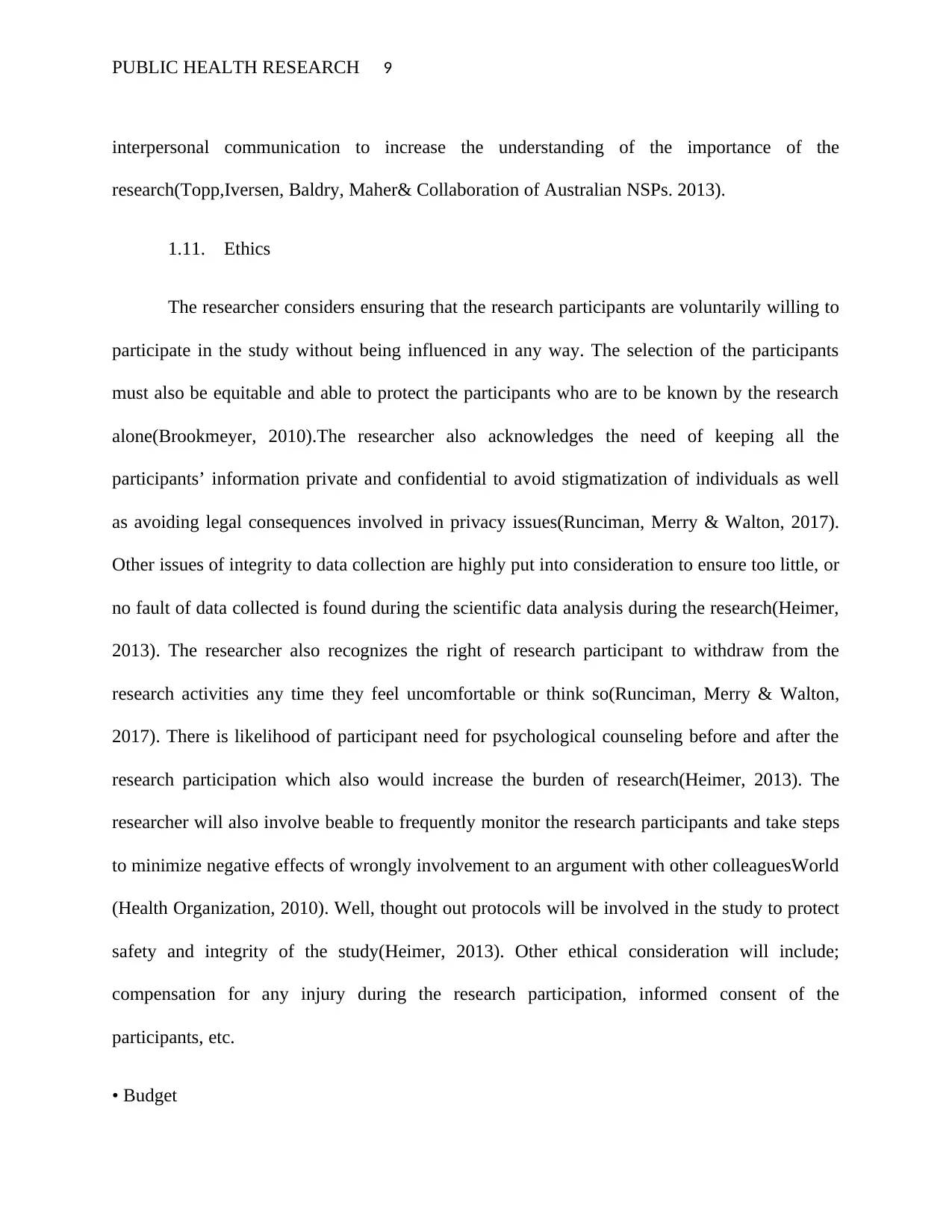
PUBLIC HEALTH RESEARCH 9
interpersonal communication to increase the understanding of the importance of the
research(Topp,Iversen, Baldry, Maher& Collaboration of Australian NSPs. 2013).
1.11. Ethics
The researcher considers ensuring that the research participants are voluntarily willing to
participate in the study without being influenced in any way. The selection of the participants
must also be equitable and able to protect the participants who are to be known by the research
alone(Brookmeyer, 2010).The researcher also acknowledges the need of keeping all the
participants’ information private and confidential to avoid stigmatization of individuals as well
as avoiding legal consequences involved in privacy issues(Runciman, Merry & Walton, 2017).
Other issues of integrity to data collection are highly put into consideration to ensure too little, or
no fault of data collected is found during the scientific data analysis during the research(Heimer,
2013). The researcher also recognizes the right of research participant to withdraw from the
research activities any time they feel uncomfortable or think so(Runciman, Merry & Walton,
2017). There is likelihood of participant need for psychological counseling before and after the
research participation which also would increase the burden of research(Heimer, 2013). The
researcher will also involve beable to frequently monitor the research participants and take steps
to minimize negative effects of wrongly involvement to an argument with other colleaguesWorld
(Health Organization, 2010). Well, thought out protocols will be involved in the study to protect
safety and integrity of the study(Heimer, 2013). Other ethical consideration will include;
compensation for any injury during the research participation, informed consent of the
participants, etc.
• Budget
interpersonal communication to increase the understanding of the importance of the
research(Topp,Iversen, Baldry, Maher& Collaboration of Australian NSPs. 2013).
1.11. Ethics
The researcher considers ensuring that the research participants are voluntarily willing to
participate in the study without being influenced in any way. The selection of the participants
must also be equitable and able to protect the participants who are to be known by the research
alone(Brookmeyer, 2010).The researcher also acknowledges the need of keeping all the
participants’ information private and confidential to avoid stigmatization of individuals as well
as avoiding legal consequences involved in privacy issues(Runciman, Merry & Walton, 2017).
Other issues of integrity to data collection are highly put into consideration to ensure too little, or
no fault of data collected is found during the scientific data analysis during the research(Heimer,
2013). The researcher also recognizes the right of research participant to withdraw from the
research activities any time they feel uncomfortable or think so(Runciman, Merry & Walton,
2017). There is likelihood of participant need for psychological counseling before and after the
research participation which also would increase the burden of research(Heimer, 2013). The
researcher will also involve beable to frequently monitor the research participants and take steps
to minimize negative effects of wrongly involvement to an argument with other colleaguesWorld
(Health Organization, 2010). Well, thought out protocols will be involved in the study to protect
safety and integrity of the study(Heimer, 2013). Other ethical consideration will include;
compensation for any injury during the research participation, informed consent of the
participants, etc.
• Budget
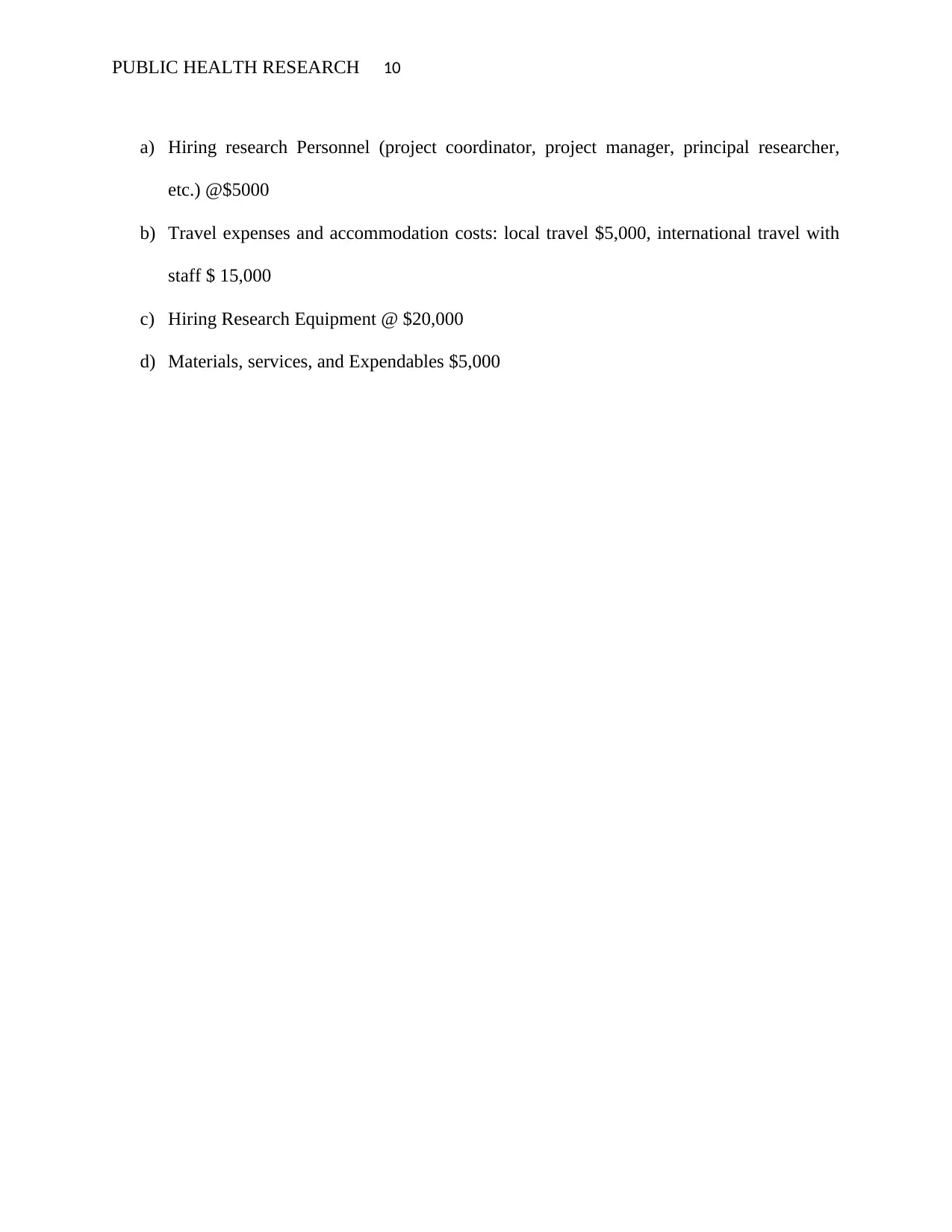
PUBLIC HEALTH RESEARCH 10
a) Hiring research Personnel (project coordinator, project manager, principal researcher,
etc.) @$5000
b) Travel expenses and accommodation costs: local travel $5,000, international travel with
staff $ 15,000
c) Hiring Research Equipment @ $20,000
d) Materials, services, and Expendables $5,000
a) Hiring research Personnel (project coordinator, project manager, principal researcher,
etc.) @$5000
b) Travel expenses and accommodation costs: local travel $5,000, international travel with
staff $ 15,000
c) Hiring Research Equipment @ $20,000
d) Materials, services, and Expendables $5,000
Secure Best Marks with AI Grader
Need help grading? Try our AI Grader for instant feedback on your assignments.
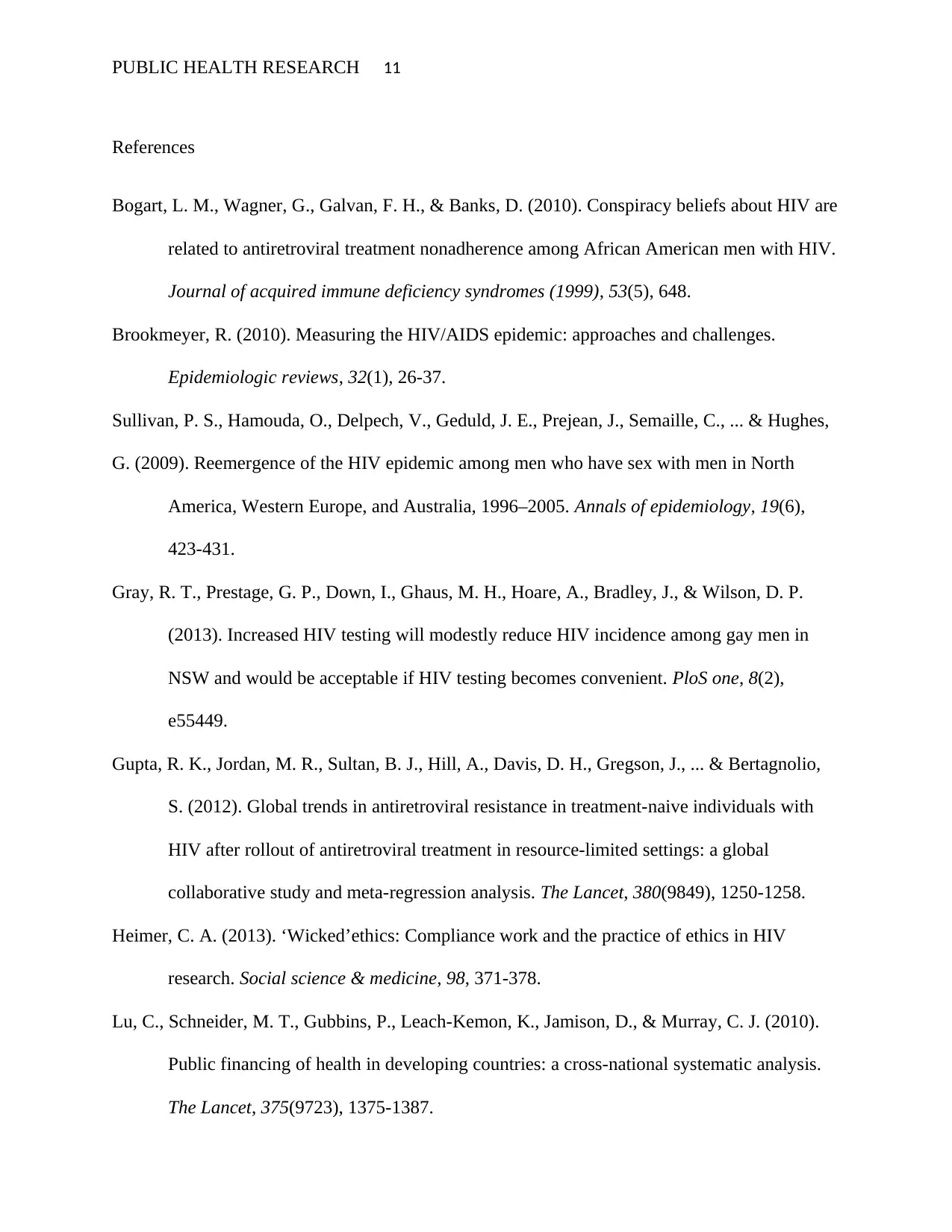
PUBLIC HEALTH RESEARCH 11
References
Bogart, L. M., Wagner, G., Galvan, F. H., & Banks, D. (2010). Conspiracy beliefs about HIV are
related to antiretroviral treatment nonadherence among African American men with HIV.
Journal of acquired immune deficiency syndromes (1999), 53(5), 648.
Brookmeyer, R. (2010). Measuring the HIV/AIDS epidemic: approaches and challenges.
Epidemiologic reviews, 32(1), 26-37.
Sullivan, P. S., Hamouda, O., Delpech, V., Geduld, J. E., Prejean, J., Semaille, C., ... & Hughes,
G. (2009). Reemergence of the HIV epidemic among men who have sex with men in North
America, Western Europe, and Australia, 1996–2005. Annals of epidemiology, 19(6),
423-431.
Gray, R. T., Prestage, G. P., Down, I., Ghaus, M. H., Hoare, A., Bradley, J., & Wilson, D. P.
(2013). Increased HIV testing will modestly reduce HIV incidence among gay men in
NSW and would be acceptable if HIV testing becomes convenient. PloS one, 8(2),
e55449.
Gupta, R. K., Jordan, M. R., Sultan, B. J., Hill, A., Davis, D. H., Gregson, J., ... & Bertagnolio,
S. (2012). Global trends in antiretroviral resistance in treatment-naive individuals with
HIV after rollout of antiretroviral treatment in resource-limited settings: a global
collaborative study and meta-regression analysis. The Lancet, 380(9849), 1250-1258.
Heimer, C. A. (2013). ‘Wicked’ethics: Compliance work and the practice of ethics in HIV
research. Social science & medicine, 98, 371-378.
Lu, C., Schneider, M. T., Gubbins, P., Leach-Kemon, K., Jamison, D., & Murray, C. J. (2010).
Public financing of health in developing countries: a cross-national systematic analysis.
The Lancet, 375(9723), 1375-1387.
References
Bogart, L. M., Wagner, G., Galvan, F. H., & Banks, D. (2010). Conspiracy beliefs about HIV are
related to antiretroviral treatment nonadherence among African American men with HIV.
Journal of acquired immune deficiency syndromes (1999), 53(5), 648.
Brookmeyer, R. (2010). Measuring the HIV/AIDS epidemic: approaches and challenges.
Epidemiologic reviews, 32(1), 26-37.
Sullivan, P. S., Hamouda, O., Delpech, V., Geduld, J. E., Prejean, J., Semaille, C., ... & Hughes,
G. (2009). Reemergence of the HIV epidemic among men who have sex with men in North
America, Western Europe, and Australia, 1996–2005. Annals of epidemiology, 19(6),
423-431.
Gray, R. T., Prestage, G. P., Down, I., Ghaus, M. H., Hoare, A., Bradley, J., & Wilson, D. P.
(2013). Increased HIV testing will modestly reduce HIV incidence among gay men in
NSW and would be acceptable if HIV testing becomes convenient. PloS one, 8(2),
e55449.
Gupta, R. K., Jordan, M. R., Sultan, B. J., Hill, A., Davis, D. H., Gregson, J., ... & Bertagnolio,
S. (2012). Global trends in antiretroviral resistance in treatment-naive individuals with
HIV after rollout of antiretroviral treatment in resource-limited settings: a global
collaborative study and meta-regression analysis. The Lancet, 380(9849), 1250-1258.
Heimer, C. A. (2013). ‘Wicked’ethics: Compliance work and the practice of ethics in HIV
research. Social science & medicine, 98, 371-378.
Lu, C., Schneider, M. T., Gubbins, P., Leach-Kemon, K., Jamison, D., & Murray, C. J. (2010).
Public financing of health in developing countries: a cross-national systematic analysis.
The Lancet, 375(9723), 1375-1387.

PUBLIC HEALTH RESEARCH 12
Negin, J., Nemser, B., Cumming, R., Lelerai, E., Amor, Y. B., & Pronyk, P. (2012). HIV
attitudes, awareness and testing among older adults in Africa. AIDS and Behavior, 16(1),
63-68.
Park, B. J., Wannemuehler, K. A., Marston, B. J., Govender, N., Pappas, P. G., & Chiller, T. M.
(2009). Estimation of the current global burden of cryptococcal meningitis among
persons living with HIV/AIDS. Aids, 23(4), 525-530.
Roberts, N., Holden, J., Duck, T., & Kitchener, S. (2015). Health promotion steroids': the value
of an experiential approach to promote rapid HIV testing in NSW, Australia. Public
Health Res Pract, 25(2), e2521522.
Runciman, B., Merry, A., & Walton, M. (2017). Safety and ethics in healthcare: a guide to
getting it right. CRC Press.
Say, L., Chou, D., Gemmill, A., Tunçalp, Ö., Moller, A. B., Daniels, J., ... & Alkema, L. (2014).
Global causes of maternal death: a WHO systematic analysis. The Lancet Global Health,
2(6), e323-e333.
Topp, L., Iversen, J., Baldry, E., Maher, L., & Collaboration of Australian NSPs. (2013).
Housing instability among people who inject drugs: results from the Australian needle
and syringe program survey. Journal of Urban Health, 90(4), 699-716.
World Health Organization. (2015). World health statistics 2015. World Health Organization.
World Health Organization. (2010). World health statistics 2010. World Health Organization.
Zablotska, I. B., Kippax, S., Grulich, A., Holt, M., & Prestage, G. (2011). Behavioural
surveillance among gay men in Australia: methods, findings and policy implications for
the prevention of HIV and other sexually transmissible infections. Sexual Health, 8(3),
272-279.
Negin, J., Nemser, B., Cumming, R., Lelerai, E., Amor, Y. B., & Pronyk, P. (2012). HIV
attitudes, awareness and testing among older adults in Africa. AIDS and Behavior, 16(1),
63-68.
Park, B. J., Wannemuehler, K. A., Marston, B. J., Govender, N., Pappas, P. G., & Chiller, T. M.
(2009). Estimation of the current global burden of cryptococcal meningitis among
persons living with HIV/AIDS. Aids, 23(4), 525-530.
Roberts, N., Holden, J., Duck, T., & Kitchener, S. (2015). Health promotion steroids': the value
of an experiential approach to promote rapid HIV testing in NSW, Australia. Public
Health Res Pract, 25(2), e2521522.
Runciman, B., Merry, A., & Walton, M. (2017). Safety and ethics in healthcare: a guide to
getting it right. CRC Press.
Say, L., Chou, D., Gemmill, A., Tunçalp, Ö., Moller, A. B., Daniels, J., ... & Alkema, L. (2014).
Global causes of maternal death: a WHO systematic analysis. The Lancet Global Health,
2(6), e323-e333.
Topp, L., Iversen, J., Baldry, E., Maher, L., & Collaboration of Australian NSPs. (2013).
Housing instability among people who inject drugs: results from the Australian needle
and syringe program survey. Journal of Urban Health, 90(4), 699-716.
World Health Organization. (2015). World health statistics 2015. World Health Organization.
World Health Organization. (2010). World health statistics 2010. World Health Organization.
Zablotska, I. B., Kippax, S., Grulich, A., Holt, M., & Prestage, G. (2011). Behavioural
surveillance among gay men in Australia: methods, findings and policy implications for
the prevention of HIV and other sexually transmissible infections. Sexual Health, 8(3),
272-279.
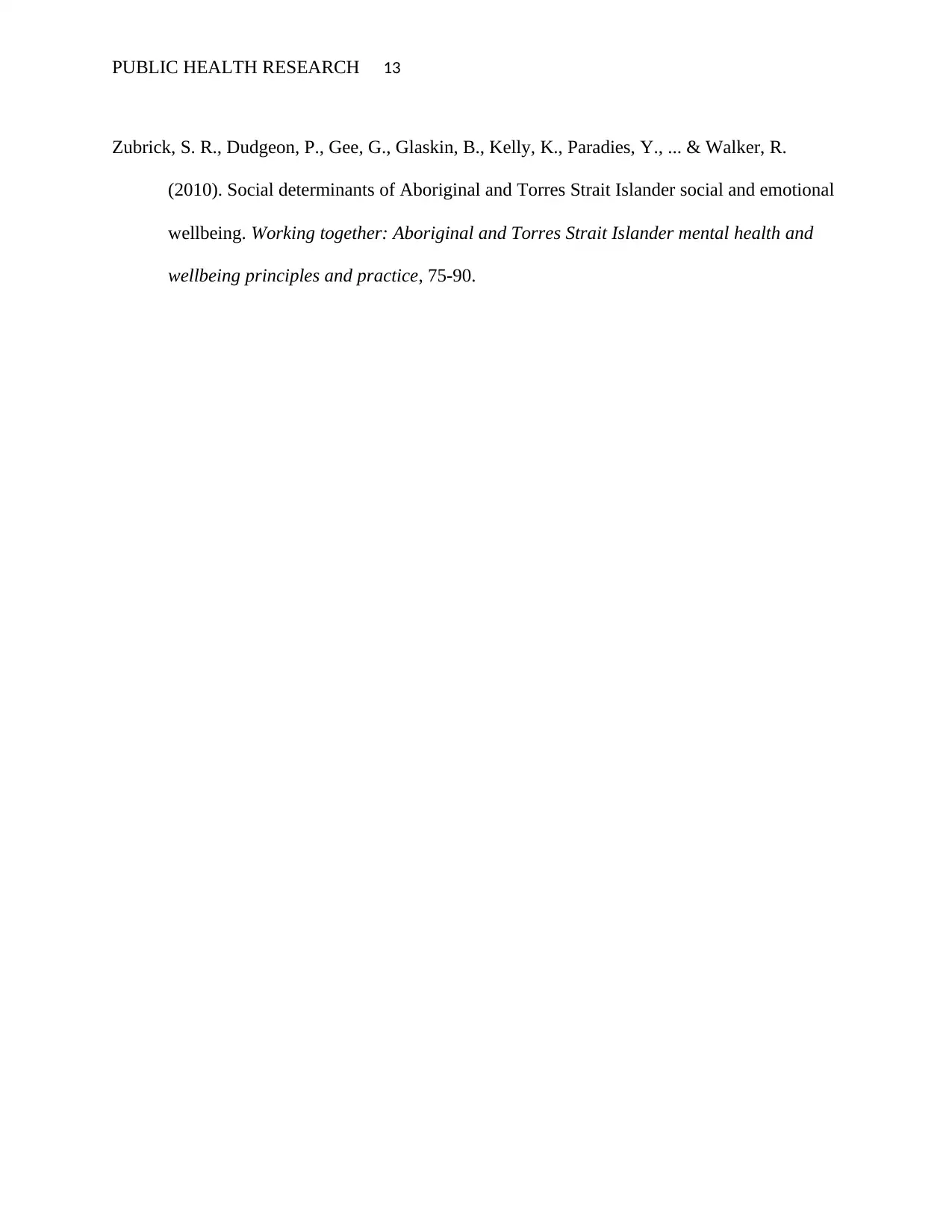
PUBLIC HEALTH RESEARCH 13
Zubrick, S. R., Dudgeon, P., Gee, G., Glaskin, B., Kelly, K., Paradies, Y., ... & Walker, R.
(2010). Social determinants of Aboriginal and Torres Strait Islander social and emotional
wellbeing. Working together: Aboriginal and Torres Strait Islander mental health and
wellbeing principles and practice, 75-90.
Zubrick, S. R., Dudgeon, P., Gee, G., Glaskin, B., Kelly, K., Paradies, Y., ... & Walker, R.
(2010). Social determinants of Aboriginal and Torres Strait Islander social and emotional
wellbeing. Working together: Aboriginal and Torres Strait Islander mental health and
wellbeing principles and practice, 75-90.
1 out of 13
Related Documents
Your All-in-One AI-Powered Toolkit for Academic Success.
+13062052269
info@desklib.com
Available 24*7 on WhatsApp / Email
![[object Object]](/_next/static/media/star-bottom.7253800d.svg)
Unlock your academic potential
© 2024 | Zucol Services PVT LTD | All rights reserved.





